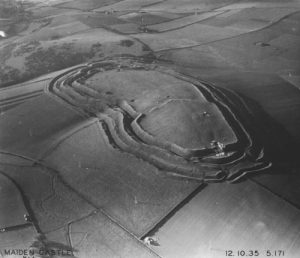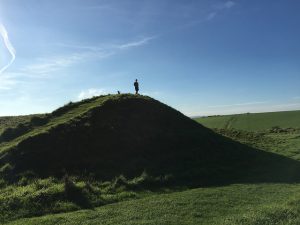Castle Coverage – Maiden Castle

Aerial photograph by Major George Allen

A photograph by Andy Lamb showing the sheer scale of the mounds
There are well over a thousand known iron age hill forts in the UK, but Maiden Castle is the biggest. It may even be the biggest in Europe. If any of them deserve the title Castle, then it’s Maiden Castle in Dorset.
Hill forts consist of earthen embankments and ditches around a hill top. Maiden Castle has four sets of embankments around the highest hill in the area. When it was built, the ditches cut into the hill embankments would have revealed the chalk under the grass, making them bright white. I like to think they kept them clean to make the hill fort more impressive and obvious. People lived inside the forts and farmed the areas outside.
That’s pretty much everything we know for certain about hill forts.
The people who lived in them didn’t have a written language, and they were going into decline by the time to Romans arrived, so archaeologists have had to reconstruct things from evidence found on these sites, and the occasional written record from outsiders, plus generalising from other sites. You see these places are old!
The Unknown and the Ancient
The earliest evidence of occupation is about six thousand years ago, when some kind of bank and ditch causeway was constructed on the hill top. The ditches were narrow and the banks low, so it was in no way a fortification. But the chalk would have been revealed, and the inside and outside would be very clear. Maybe it was a territory marker, visible from miles around, or perhaps people lived inside and it was like the town boundary. Or it could have been used for some religious purposes – a hilltop seems like a good place to worship a sky god to me! The truth is we really have very little idea what neolithic people did all day, and even less idea of what they did here. There are the graves of two children from that time, but we have no idea who they were or why they were buried here. There are multiple arrowheads, which might mean the place was attacked, and a little later there is a barrow which, unusually, does not contain any burials. Maybe they were symbolically burying something – a dead tribe perhaps, or their conquered enemy’s dead god?
The area fell out of use for a while… and by a while I mean over three thousand years. Something might have happened in the interim, but we have no evidence.
Rings and Iron
Barring a brief period of farming around 1800 BC, things get interesting again in about 600BC. As hill forts were beginning to appear in the late bronze age or early iron age, one was built on this site. It was one of at least thirty in the immediate area, it had a single bank and ditch and was nothing particularly unusual. People definitely lived inside these enclosures, there is evidence of houses and even industries – we don’t know what was happening at Maiden Castle, but flint was mined and worked at Cissbury Ring in Sussex.
Things must have been changing relatively rapidly in Britain at the time – in the space of just a few generations these enclosures started to spring up, and new metals became available for tools and weapons. There must have been social turmoil – maybe the old gods were being replaced with new, maybe the old elites were being driven out and new leaders installed. The banks and ditch would have been a good defence, so they may have been war, or at least raiding parties – they could have been neighbouring tribes, or invaders from the continent. But despite these changes, the past clearly still mattered: many hill forts (including Maiden Castle) are situated near much older religious sites – although that could be simply strategic locations, or it could be at attempt to supercede the old religions.
About a hundred and fifty years later, many hill forts started falling out of use, and a few became more densely populated. Maiden Castle grew the most out of all of them, more than tripling in size. They added three more banks and two more ditches around the outside (except on one side where it was too steep for the third extra bank), and incorporated the next hill top (which is actually very slightly higher – why they didn’t choose the higher point a few meters away remains unknown). This expansion made it the largest hill fort in the UK, and possibly in Europe.
There is evidence of a palisade wall on the innermost bank, and sling stones have been found, gathered and ready for use. The ditches were deep, the embankments high, it was at the top of a hill and while trying to run up and down them to break through a wall you would be pelted with sling stones, and no doubt taunted and insulted. You could try the main gate, but the ditches and banks would funnel you into carefully constructed and easily defended bottlenecks. It would not be an easy place to assault with iron age technology. The principle remains true, of course – take a look at Fort George which i wrote about last week. Even now, two and half thousand years later, only the most determined would try to mount an assault over those embankments.
The houses (roundhouses) inside were in neatly aligned rows, and there were a few larger buildings which may have been higher status or communal buildings. There is evidence of iron working, but there’s no decent source of ore near by so it would have had to be brought in, probably from Sussex, Cornwall and Wales. Other structures, thought to be granaries, suggest it was a key administrative centre, and a place where people kept and stored their farmed goods.
We don’t know why people started to build larger hill forts, nor why they abandoned the smaller ones, but it was a clear and dramatic cultural shift. The apparent trade suggests that war with the neighbours wasn’t the reason (unless of course the iron ore was gathered through raiding not trading), but the increase in defense suggests it was a dangerous time.
Just a few hundred years later, though, inhabitation decreased, limited to only one end of the site. The influence of the Roman Empire just across the channel would have had a profound impact on the culture as coinage and new gods started to arrive – perhaps that is what caused the fall of the hill forts. By the time the Romans invaded in 43 AD it was comparatively uninhabited and nowhere near as formally an neatly laid out. A few burials have been found, so there’s a possible story of the Roman armies attacking Maiden Castle, defeating the brave defenders and laying waste to the place – but there’s little evidence to support that. Ptolemy says in the 2nd century AD that somewhere called Dunium was the main residence of a tribe called the Durotriges, and for a long time it was believed that he was referring to Maiden Castle, but there are at least two other places he could have been talking about.
In Your Games and Stories
Maiden Castle has a truly ancient history, dating all the way back to the stone age. It’s not a construction of stone but it has just as much to tell.
The classic use of an ancient hill fort in a fantasy story is as a place for some ancient artifact or information to be uncovered. What secret truth did the Durotriges or their predecessors know that is now long forgotten? The original ancient causeway enclosure could be a portal to (or from) some other realm – the underworld perhaps, or some realm with daemons the ancient treated as gods.
Or it may make a great site for a battle. Even with more advanced technology than slings and arrows those ramparts would serve their purpose – look at Fort George from last week, where they built earthen ramparts to stop cannon. Its location would give a great view over the surrounding area, allowing army movements to be monitored, or a signal fire to be lit.
But entire stories could be set when it was inhabited. At its height Maiden Castle was the largest settlement in the country. It would have been a bustling place with farmers coming and going, traders making stops there on their continent spanning routes, and iron workers smelting and working their metal with almost god-like power. If and when the place was attacked it would be cramped and crowded, noisy and smelly. There are surely hundreds of tales which could be told about such a place!
What Is A Castle?
This is fifth and final piece about castles (for the time being at least), and I have looked five very different places. Bodiam, Harlech, Tintagel, Fort George and now Maiden Castle. Bodiam was a stately home built by a pretender as a show of force; Harlech was a tool of invasion and conquest, Tintagel harks back to romantic myths, Fort George looked forward to new forms of warfare, and Maiden was a tribal centre.
A castle is two things. It must be a military, defensive structure, and it must be a high status home. By this standard Maiden Castle scores higher than any of the others. Bodiam was never intended to fight (though it could have done) Harlech was never intended as a royal residence (though it became one), Tintagel can claim neither in truth (though it claims both in myth), and Fort George is purely military (though royals have visited in that capacity). Marden castle has strong defences, and whoever ruled it at its height could claim to be at least a local lord if not a king by any reasonable standard.
And yet, when we think of a castle, we think of Bodiam, or Harlech, or even Tintagel. Must a castle be made of stone walls and crenelated towers?
A castle is so much more than just a military outpost, it is so much more than a palace. A castle is a statement, it exudes control, it’s a strong point and a place of power. People lived and died in them and for them. Those people are long gone but their work and their legacy still stands centuries, even millennia later.
So tell their stories. Invent your own stories, make up your own castles…
And maybe…
Just maybe…
Your legacy will live on for millennia too.
